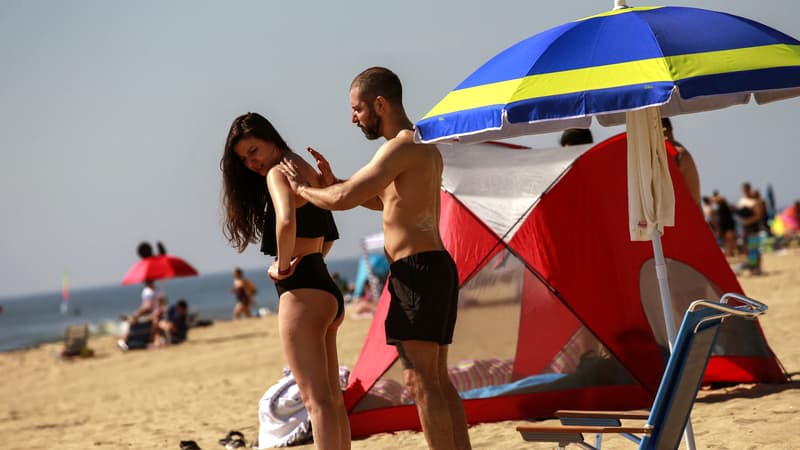Make labels simpler and clearer to better protect consumers. As part of the ongoing review of the European Union (EU) recommendation to manufacturers “on the safety and efficacy claims” of sun protection products, ANSES publishes this Wednesday, December 11, an opinion with its recommendations.
“Labeling should focus on essential information to allow consumers to better identify the level of sun protection intended (…) so that the purchased product is especially adapted to their skin type and the intensity of sun exposure,” writes the agency.
Protect against UVB and UVA rays
A sunscreen product should protect against both UVB and UVA rays. Ultraviolet A rays penetrate deeply into the skin and are responsible for its aging.
B only penetrates the epidermis, that is, the superficial layer of the skin. They are the main culprits of sunburn. “UVB rays are 1,000 times more powerful than UVA rays,” ANSES specifies. “Although UVB rays constitute the main factor in skin cancers because they can directly alter DNA, UVA rays play an important role in their appearance,” adds the organization in its opinion this Wednesday.
ANSES recommends removing the sun protection factor (SPF) from labels, which reflects the level of protection against UVB that a sunscreen provides, and the UVA logo.
Instead, it proposes maintaining only three categories: low, medium or strong protection, which would be related to protection against both types of UV rays. This would “focus users’ attention on overall protection performance.”
For Anses, “SPF generates a biased perception among consumers when comparing the performance of protection against all UV rays, while it only reflects protection against UVB.”
Six teaspoons of lotion
In these new categories, “low protection” would group products that currently show an SPF of 15 and 20, “medium protection” those with an SPF of 25 or 30, and “high protection”, SPF 50 and 50+.
ANSES states that 50+ sunscreens “do not significantly increase protection against UV radiation compared to products with SPF 50.” “However, this mention may give the impression that they offer such protection that consumers could expose themselves to more sun,” writes the agency, which therefore suggests removing the “very high protection” category.
Scientists also recommend that labels include indications on the amount of product to apply, adapted to the product formulation (cream, sprays, stick, oil, foam, etc.). “For example, for a lotion, you would apply six teaspoons of lotion (approximately 36 grams) to the entire body of an average adult,” they illustrate.
The mention “children” should be prohibited
Special attention is paid to creams intended for babies and children. For ANSES, this mention should simply be prohibited because it would bias the information.
The scientific organization recalls “that exposure of babies and young children to the sun is contraindicated because they are more vulnerable to the carcinogenic effects of UV rays.” In fact, for the entire population, exposure to ultraviolet rays is the main risk factor for skin cancer.
Consequently, ANSES considers that specifying that a product is intended for small children may lead people to think that they can be exposed to the sun without fear. “Using a sunscreen product should remain a solution of last resort, in addition to preventative measures,” he writes. Speaking to AFP, Céline Druet, deputy director of the ANSES risk assessment department, adds that children should not be placed under an umbrella, where they are exposed to diffuse or reflected radiation.
For children but also for the rest of the population, it is recommended to seek shade, wear protective clothing, limit the duration of exposure and avoid times of day when UV radiation is most intense.
Be careful with cosmetics with sunscreen
ANSES also focuses on another problem according to it: cosmetic products that contain sunscreen. There are more and more products on the market (in particular day creams, makeup bases, lip balms, etc.) that also promise protection against the harmful effects of the sun.
This type of product can “bring confusion about its level of protection with respect to the risks associated with exposure to UV rays,” laments ANSES. In fact, these cosmetics do not have as their first and main objective to protect against UV radiation. Consequently, consumers think that they are protected, although many times they have only applied this product once in the morning and in much smaller quantities than necessary to really be better protected.
Therefore, ANSES recommends that these products cannot claim sun protection by placing an SPF on the label.
Finally, always in terms of labeling, ANSES recommends integrating into the European recommendation the issue of the harmful effects of UV filters on various aquatic organisms, prohibiting the claims and logos of certain sun protection products that promote respect for the marine environment. , “without having demonstrated its effectiveness.” security”.
Source: BFM TV


